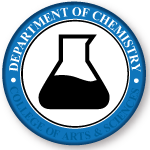Document Type
Article
Publication Date
3-2000
Publication Title
Journal of Medicinal Chemistry
Volume
43
Issue
6
First Page
1234
Last Page
1241
Abstract
Two tetramethyl-substituted dispiro-1,2,4,5-tetraoxanes (7,8,15,16-tetraoxadispiro[5.2.5.2]- hexadecanes) 3 and 4 were designed as metabolically stable analogues of the dimethylsubstituted dispiro-1,2,4,5-tetraoxane prototype WR 148999 (2). For a positive control we selected the sterically unhindered tetraoxane 5 (7,8,15,16-tetraoxadispiro[5.2.5.2]hexadecane), devoid of any substituents. Tetraoxanes 3 and 4 were completely inactive in contrast to tetraoxanes 2 and 5. We hypothesize that the two inactive tetraoxanes possess sufficient steric hindrance about the tetraoxane ring due to the two additional axial methyl groups to prevent their activation to presumed parasiticidal carbon radicals by inhibiting electron transfer from heme or other iron(II) species. For each of the tetraoxanes 2-4, the tetraoxane and both spirocyclohexyl rings are in a chair conformation and the bond lengths and angles are all quite normal except for the C1-C2 bond which is slightly lengthened. Comparison of the modeled and X-ray structures for tetraoxanes 2-5 reveals that molecular mechanics (MMX and MM3) and 3-21G* calculations each gave accurate structural parameters such as bond lengths, bond angles, and dihedral angles. In contrast, semiempirical methods such as AM1 gave poor results.
Recommended Citation
McCollough, Kevin J.; Wood, James K.; Walter Reed Army Institute of Research; Dong, Yuxiang; Walter Reed Army Institute of Research; Walter Reed Army Institute of Research; and Vennerstrom, Jonathan L., "Methyl-Substituted Dispiro-1,2,4,5-tetraoxanes: Correlations of Structural Studies with Antimalarial Activity" (2000). Chemistry Faculty Publications. 17.
https://digitalcommons.unomaha.edu/chemfacpub/17


Comments
Copyright © 2000 American Chemical Society.